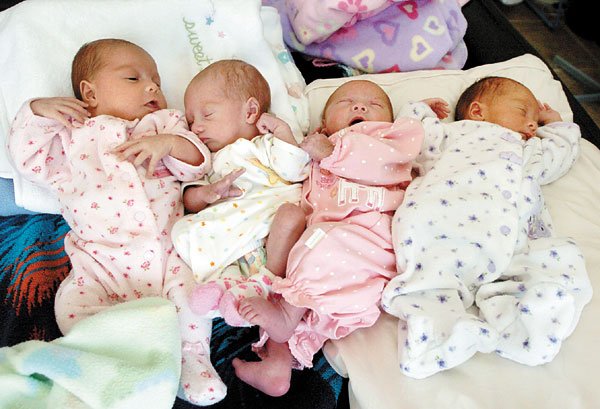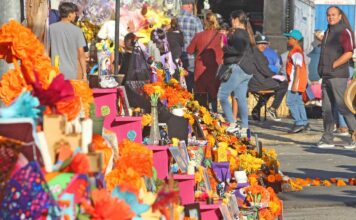Gilroy
– In four minutes on March 7, Janeth Hudson became a mother of
four squirming girls: Nina, Ally, Claire and Lauren, each just
tipping 4 pounds. Their names spell CLAN, and husband Craig calls
them just that: The Hudson clan.
Gilroy – In four minutes on March 7, Janeth Hudson became a mother of four squirming girls: Nina, Ally, Claire and Lauren, each just tipping 4 pounds. Their names spell CLAN, and husband Craig calls them just that: The Hudson clan.
A month later, the whole clan is home in Gilroy, and the Hudson house is “chaos,” says Craig, 49. At daybreak, red-eyed Janeth juggles formula and coffee; at noon, the Hudsons change the babies’ diapers on a pool table. All four are hungry at the same time. All four are wet at the same time. When one has finally dozed to sleep, another is bawling. Even the girls’ baths must be carefully choreographed – and golfing, Craig tells a friend, is out of the question. That is, if he wants to stay married.
“It was a piece of cake when only three had come home!” Janeth Hudson, now 38, said. The girls were released one by one from the hospital to the Hudsons, and each time they adjusted, another came home. “Three is manageable but four is a whole different ballgame.”
Fellow quadruplet mom Angela Campbell agrees. “That’s exactly what I said – and it’s crazy talk, obviously.”
Nothing has come easily to the Hudsons. Janeth couldn’t conceive for more than two years, after thousands of dollars of fertility treatments. When sperm finally met egg, on the couple’s third attempt at in-vitro fertilization, four embryos appeared. Multiple pregnancies are 100 times more likely among couples who use fertility treatments than those who don’t, said Dr. Paul Meyer, the couple’s perinatologist – but at 1 in 6,000, still rare.
Janeth text-messaged her mother in the Phillipines; friends were stunned, especially since Campbell, who worked alongside Janeth Hudson as a nurse in Kaiser Santa Teresa’s Intensive Care Unit, gave birth to healthy quadruplets in October.
“Now everyone’s saying, ‘Don’t drink the water there,'” Campbell joked.
Doctors warned that a quadruplet birth would be risky for babies and mother: Quadruplet mortality rates range from 6.7 to 11.7 percent, said Meyer. Quad moms often suffer high blood pressure, diabetes, and other complications – not to mention astronomical bills, once the babies are born. As a high-risk birth specialist, Meyer had delivered two sets of quadruplets before. One died, and one – Campbell’s quads – lived.
“Ultimately,” said Janeth Hudson, “we left it up to God.”
Like any babies, the quads’ chance at survival increased with each week in the womb. Giving birth at 22 weeks is usually fatal; 28 weeks is golden. A typical pregnancy lasts 37 to 40 weeks, but quads are often born earlier, smaller and sicker. Every Sunday, Craig gave Janeth a gift, to mark another week achieved. At first, he gave her books and puzzles, things to divert her from worrying. As the weeks progressed, so did the gifts: A Coach diaper bag. A video iPod. On the 28th week, he gave her a drop necklace made of two diamonds and four pink sapphires, symbolizing the couple and their girls.
“The doctor joked, ‘I want you to keep going, but he’ll go broke,’ ” Janeth recalled, smiling.
Doctors recommend that quadruplet mothers gain at least 80 pounds – a sum that shocked Janeth Hudson. High-calorie meals, in turn, gave her gestational diabetes, and forced her to trade the rice-heavy Filipino meals she grew up with for ice cream, pistachios and protein shakes. Over Christmas of 2006, her cervix shortened, and she went into the hospital. It had been 22 weeks.
As Janeth’s belly grew, Craig built a Web site to chronicle her pregnancy. In Wisconsin, Craig’s family clicked for updates; in England, Janeth’s friends checked whether she’d gone into labor. Janeth Hudson bounced between home and the hospital for weeks, until finally, at 33 and a half weeks, Janeth underwent a C-section, and the four girls entered the world.
“It was beyond our wildest dreams,” said Meyer. “It was an amazing coincidence to have two nurses that worked in the same hospital, in the same medical unit, who ended up having quadruplet pregnancies within months – and that both of them did so remarkably well.”
Today, the Hudsons’ lives are hectic but happy. Neighbors and friends from a triplets-and-more support group have donated strollers, a crib, even a $250 car seat – one of four poised in a brand-new minivan, soon to bear a vanity plate: “H (heart) QUADS”.
“So far, we haven’t had to buy anything for these babies,” Janeth said, “and we haven’t had to do it alone.”
“Oh no,” said Craig. “There’s no way two people could do this.”
Janeth’s parents, Luningning and Norman Cadelina, flew from the Phillipines to pitch in for six months; Janeth’s two brothers help cook and clean. Campbell reassures Janeth Hudson: It does get easier. Meanwhile, Craig struggles to keep costs down, buying discount formula in bulk on eBay. Each month, the girls soil more than 1,000 diapers, at a $300 price tag, and gulp down more than $150 of formula.
Between feedings and baths, doctors’ appointments and diaper runs, they ask each other: On birthdays, should we buy four cakes, or one? One gift, or four? How much do six airplane tickets to the Phillipines cost? And when the day comes, how are we going to survive homecoming?
“We’re still riding on adrenaline,” Craig said, grinning. “It’s going to be as hectic as you can believe – and it’s still going to be fun.”














